A food processor delivers smooth, creamy hummus quickly with minimal effort, ensuring consistent texture by efficiently blending chickpeas and tahini. In contrast, a mortar and pestle allows hands-on control over the hummus' texture, preserving a rustic, chunky feel and enhancing flavor through gentle grinding. Choosing between the two depends on whether you prioritize convenience and speed or traditional texture and artisanal quality in your hummus preparation.
Table of Comparison
| Method | Texture | Preparation Time | Flavor | Ease of Use | Cleaning | Best For |
|---|---|---|---|---|---|---|
| Food Processor | Smooth and Consistent | 5-10 minutes | Neutral, allows added flavors to stand out | Easy and Quick | Dishwasher safe parts | Large batches, fast preparation |
| Mortar and Pestle | Coarser, Chunky | 15-20 minutes | Richer, more robust, natural | Requires Effort and Skill | Hand wash only | Small batches, traditional texture |
Introduction to Hummus Preparation Methods
Hummus preparation methods vary significantly between using a food processor and a mortar and pestle, each influencing texture and flavor outcomes. A food processor offers quick, consistent blending ideal for smooth, creamy hummus, while a mortar and pestle provide a traditional technique that enhances texture through manual grinding, preserving a chunkier, more rustic finish. Choosing between these tools depends on desired texture, preparation time, and preference for authentic taste versus convenience in homemade hummus recipes.
Food Processor: Modern Convenience for Hummus
A food processor offers unmatched speed and consistency for hummus preparation, effortlessly blending chickpeas, tahini, and olive oil into a smooth, creamy texture. Its powerful motor and sharp blades reduce prep time significantly compared to traditional methods, ensuring evenly pureed hummus with minimal effort. This modern kitchen appliance handles large batches efficiently, making it ideal for both everyday use and gatherings.
Mortar and Pestle: Traditional Hummus Technique
The mortar and pestle method preserves the authentic texture and flavor of hummus by gently grinding chickpeas and tahini, releasing essential oils for a richer taste. This traditional technique allows precise control over the consistency, creating a creamy yet slightly coarse hummus that honors Middle Eastern culinary heritage. Using a mortar and pestle enhances the sensory experience, producing hummus with a depth of flavor often lost in food processor blends.
Texture Differences: Creamy vs Rustic Hummus
A food processor produces a smooth, creamy hummus by finely blending chickpeas and tahini, creating a velvety texture ideal for dipping and spreading. In contrast, using a mortar and pestle yields a rustic hummus with a coarser, chunkier consistency that preserves more of the chickpeas' natural texture and offers a traditional mouthfeel. Choosing between the two methods depends on whether a silky or textured hummus is preferred in the culinary experience.
Flavor and Aroma: Does the Method Matter?
Using a mortar and pestle for hummus preparation enhances flavor and aroma by crushing chickpeas and spices more thoroughly, releasing essential oils and creating a richer, more complex taste profile. Food processors generate a smoother texture but can produce heat that slightly diminishes the nutty aroma and fresh taste of ingredients. Traditional methods preserve the authentic essence of hummus, making the choice of tool crucial for flavor intensity and aromatic depth.
Speed and Efficiency Comparison
Food processors significantly reduce hummus preparation time by swiftly blending chickpeas and tahini into a smooth consistency within minutes. Mortar and pestle, though traditional, require manual effort and more time to achieve the same texture, making it less efficient for large batches. For quick, consistent results, especially in commercial or busy kitchen settings, food processors are the superior choice.
Cleaning and Maintenance Challenges
Cleaning a food processor after making hummus involves disassembling multiple parts like the blade, bowl, and lid, which can be time-consuming but dishwasher-safe components often simplify maintenance. In contrast, a mortar and pestle require less disassembly but demand thorough hand scrubbing to remove the sticky texture of chickpeas and tahini, making cleanup labor-intensive and prone to lingering odors. Both tools present unique challenges, with the food processor favoring convenience through removable parts and the mortar and pestle requiring careful manual cleaning to maintain hygiene.
Equipment Cost and Availability
Food processors typically cost between $50 and $200, offering widespread availability in most kitchen appliance stores and online, making them a convenient choice for hummus preparation. Mortar and pestle sets, often priced between $20 and $70, provide a traditional method with easy availability at specialty kitchenware shops and markets. The choice between these tools depends on budget constraints and accessibility, with food processors being a higher-cost but time-saving option and mortar and pestle offering an affordable, hands-on experience.
Authenticity: Which Method Honors Tradition?
Using a mortar and pestle to prepare hummus preserves the authentic texture and flavor developed through centuries of Middle Eastern culinary tradition, as its slow grinding releases essential oils from ingredients like chickpeas and tahini. A food processor offers convenience and speed, but can over-process the mixture, yielding a less textured and slightly different taste that some argue lacks the genuine rustic quality. For purists seeking to honor traditional methods, the mortar and pestle remains the preferred tool to achieve hummus with true depth and artisanal character.
Choosing the Best Method for Your Hummus
A food processor delivers smooth, creamy hummus quickly by efficiently blending chickpeas, tahini, and olive oil, making it ideal for large batches or everyday convenience. Mortar and pestle provide a rustic texture and allow for greater control over consistency, enhancing the flavors through gentle grinding that releases essential oils. Choosing between these methods depends on your preferred hummus texture and preparation time, balancing modern efficiency with traditional craftsmanship.
Food Processor vs Mortar and Pestle for hummus preparation Infographic

 cookingyes.com
cookingyes.com